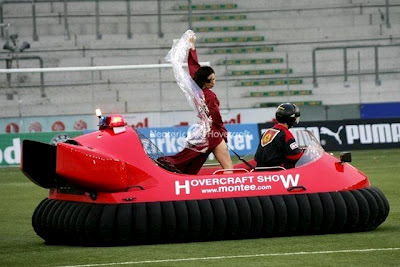Recently, Christy Hovercraft participated in an international
conference/exhibition held in Russia by EMERCON, the Chief Department of the
Russian Emergency Services Ministry. EMERCON manages all civil defense and
search and rescue operations in Russia. A focus of the event was the study of
Russian and international experience in search and rescue operations using
high-performance hovercraft, with an emphasis on their effectiveness in flood
rescue operations and in adverse weather.
The last half of this video taken at the exhibition features a demonstration of the
Neoteric Hovertrek's unusual maneuverability on shallow water and sand, due to its patented reverse thrust system:
Igor V. Lavrov, President of Christy Hovercraft, reports, “The Hovertrek attracted great interest from senior governmental officials who took part in this conference. A Deputy Chairman of the Council of the Federation tested the Hovertrek’s controls and reverse thrust system himself. (The Council is the upper chamber of the Federal Assembly, the parliament of the Russian Federation.) Our products aroused great interest among the higher ranks of EMERCON. It was noted that Neoteric hovercraft are extremely mobile, amphibious, have a low-profile design, good ergonomics and low maintenance ... all beneficial attributes for emergency work.”
The following Russian dignitaries were among those who
expressed interest in the unique versatility of the Neoteric Hovertrek in
rescue operations:
Yuri Leonidovich Vorobyov, Deputy Chairman of the Council of
the Federation. Yuri Vorobyov is also a “Hero of the Russian Federation” and
“Honored Rescuer” of the Russian Federation.
Vladimir Artamonov, Deputy Minister of Emergency Situations
Viktor Ryabishin, First Deputy Governor of the Vologda
region
Shamsutdin Sharabutdinovich Dagirov, Director of the
North-West Regional Emergency Center
Viktor Klimkin, Director of FSBI EMERCON, the Russian
Research Institute for Fire Protection.
 |
| Igor Lavrov, President of Christy Hovercraft, presents the Neoteric Hovertrek to government officials of the Russian Federation. |
 |
| The Neoteric Hovertrek, third from left, is the lightest, quietest, and most maneuverable production hovercraft in the industry.
All of us at Neoteric would like to express our appreciation to Igor and to Christy Hovercraft for their dedicated work in introducing Neoteric hovercraft throughout the Russian Federation.
|

































